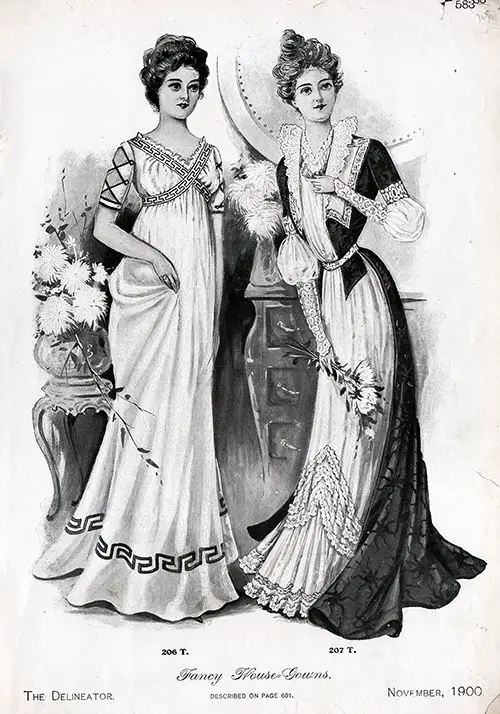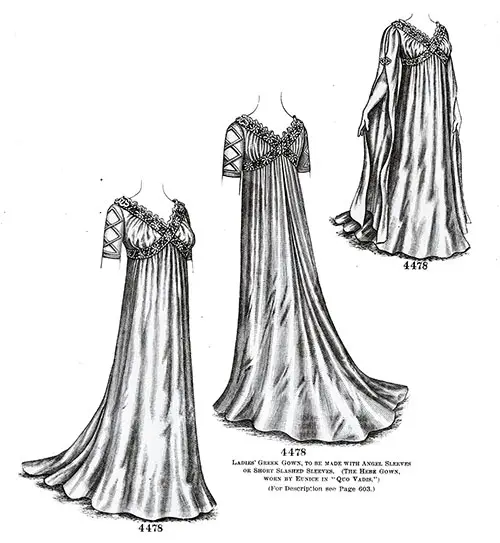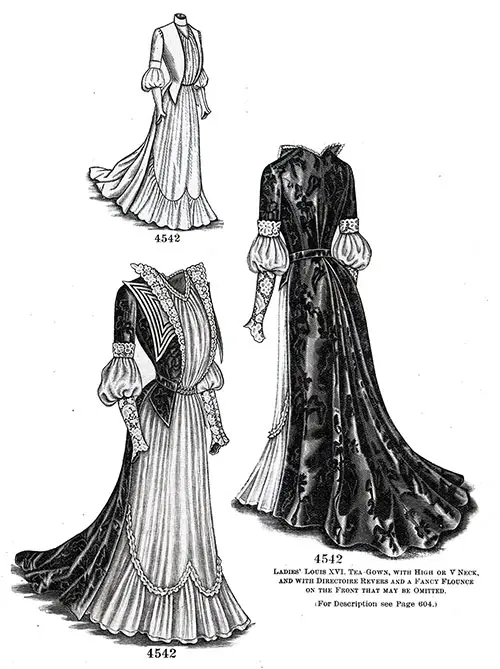Ladies Fancy House Gowns 206 T & 207 T - 1900

Ladies' Greek Gown No. 206 T
A Grecian gown that is both simple and graceful is shown at this figure developed in white albatross with black velvet ribbon in Greek-key design for garniture.
The gown, which is V necked, is gathered to form a frill heading at the top and closes at the back, where extra plaited fulness is arranged to fall into the short sweep.
Curved lines of gathers produce a short body effect, the gathers being overlaid with bands. The short, one-seam sleeves are slashed on the upper side and are decorated with narrow black velvet ribbon; they may, however, be replaced by angel sleeves that reach almost to the lower edge of the gown.
Dressmaker Options
For fancy dress wear the gown will he found very attractive developed in wailing, cashmere or soft silk, with gilt or silver braid or ribbon for garniture.
Pattern Information
The pattern, which is No. 4478 and costs Is. or 30 cents, is in four sizes for ladies from thirty to forty-two inches, bust measure, and is also shown on page 593.
Ladies’ Greek Gown No. 4478

No. 4478 Ladies’ Greek Gown, to be made with Angel Sleeves or Short Slashed Sleeves. (The Hebe Gown, worn by Eunice in “Quo Vadis.”) (For Description see Page 603.)
Description
This gown is illustrated on page 593, and also in figure No. 206 T in this magazine.
The picturesque Greek gown will be found very attractive for wear at masquerades, fancy dress affairs, or when giving a Delsarte exhibition. It is shown developed in the present instance in white vailing and is cut in one piece, the closing being at the back.
The gown, which is made over a short body-lining, is in Y outline at the neck both back and front and is gathered at the top to form a frill heading, extra fullness at the back being arranged in under-folded plaits that fall gracefully into the short sweep.
A short body effect is given by curved lines of gathers which are overlaid by embroidered straps of ribbon crossing at the front and providing a luxurious touch to the whole.
Two styles of the sleeve are included in the pattern; the short, smooth one-seam sleeve is slashed in fancy outline to reveal the arm, the slashes and lower edge being followed by golden braid.
The other design is in angel style and extends almost to the lower edge of the gown; it has gathered fulness at the top and is open on the outside of the arm all the way down, being held together near the elbow by a fancy clasp that corresponds with those decorating the shoulders.
Dressmaker Options
Soft clinging fabrics are usually selected for a gown of this style. Cashmere, China or India silk, Lansdowne, etc., are suitable, with braid or other band trimmings. For stage wear, cheese-cloth will be found very satisfactory.
Pattern Information
We have pattern No. 4478 in four sizes for ladies from thirty to forty-two inches, bust measure.
To make the gown with angel sleeves for a lady of medium size requires eight yards and one-fourth of goods thirty-six inches wide. The gown with short sleeves, needs five yards and five-eighths of material in the same width, with two yards and three-eighths of ribbon an inch and a half wide for straps.
Price of pattern, 1s. or 30 cents.
Ladies' Tea-Gown No. 207 T

The luxurious fabrics and graceful shaping of this handsome tea-gown combine to make the mode one of surpassing attractiveness.
The design is in Louis XVI style, and in its development dark satin brocade, white chiffon, all-over lace, and lace edging were used, with tinsel braid, lace appliqué and ruchings of the chiffon for ornamentation.
The gown is in Princess style at the back, plaited fulness being introduced at the waistline to fall into the graceful sweep.
The jacket fronts fall in tabs over the skirt and flare to reveal a full front that is partially outlined by fanciful revers overlapping large Directoire revers. The neck is slightly low in V shape, and a tinsel belt encircles the waist.
The front of the skirt is full and is shown in petticoat effect; it is made quite decorative by a full flounce having a scalloped upper outline, and a short body-lining supports the gown.
The sleeves are very fanciful, consisting of a close-fitting upper portion reversed to form a turn-back cuff and separated from the smooth lower portion by a full elbow puff. The gown may be high-necked.
Dressmaker Options
Satin brocade, luxurious silks, and similar materials are usually combined with some soft sheer fabric in reproducing the mode.
A gown of pink brocaded satin will be handsomely associated with white mousseline or Liberty silk and all-over lace, with ribbon or ruchings of the mousseline for garniture.
Pattern Information
The pattern, which is No. 4542 (shown above) and costs 1s. or 30 cents, is in six sizes for ladies from thirty-two to forty-two inches, bust measure, and is seen differently developed on page 595.
No. 4542 Ladies Louis XVI Tea-Gown.

Illustrations of this gown are provided on page 595, and also in figure No. 207 T in this magazine.
Description
A handsome tea-gown is now considered necessary by every woman who wishes to have her wardrobe complete.
Picturesque lines and graceful adjustment characterize this one shown in a rich combination of fabrics, consisting of black brocade, white chiffon, and plain white taffeta, with decorations of lace appliqué, velvet baby ribbon, and ruches of the chiffon.
The back is in princess style, having very slight plaited fulness at the waist-line that falls gracefully into the short sweep.
The fronts end in tabs below the waist-line and open in jacket style over a full front that closes at the left side; they are ornamented with Directoire revers over which lap long, pointed revers that stand out prettily from the figure.
The front of the skirt is shown in petticoat effect and is in full gathered style; it is mounted on a plain foundation, consisting of a front-gore and dart-fitted side-gores, and a full flounce having a fanciful upper outline is arranged about the bottom of the petticoat portion and adds much to the effectiveness of the mode.
At the neck, the gown is in a slightly low V outline, and a shaped belt held together by a silver belt section encircles the waist.
The sleeves are entirely novel, having a smooth one-seam upper part reversed to form a cuff and a full, gathered, drooping puff arranged upon a close-fitted lining, the latter being shown in deep cuff outline and fancifully scalloped at the wrist.
A chemisette topped by a high stock is included in the pattern for use when a high neck is desired. A fitted body-lining supports the gown, which is designed to give the fashionable Marie Antoinette dip in the front.
Dressmaker Options
Silk and satin brocade (plain or embroidered), panne velvet and luxurious materials, in general, are selected for developing gowns of this description in association with mousseline, Liberty or soft China silk, and decorated with lace appliqué, ruchings of ribbon or the sheer fabric.
A pretty house gown is of mauve vailing in combination with Liberty silk in a lighter shade. The decoration consists of heavy appliqué lace and wide and narrow black velvet ribbon.
Pattern Information
We have pattern No. 4542 in six sizes for ladies from thirty-two to forty-two inches, bust measure.
For a lady of medium size, the tea-gown requires seven yards and one-fourth of material twenty inches wide, with six yards and three-eighths of fabric, forty-five inches wide for the puffs, flounce, petticoat front and full front.
Additionally, a yard and one-half of cloth twenty inches wide for the revers and for facing the sleeves below the puffs and the reversed portions of the sleeves, and one yard of appliqué lace eighteen inches wide to cover the long revers, sleeve-facings and the inverted portions of the sleeves.
Price of pattern, 1s. or 30 cents.
“Descriptions of Figures in Colors, Tints, Etc., Shown on First Page of Cover and Pages 571 to 591 Inclusive,” in The Delineator: An Illustrated Magazine of Literature and Fashion, Paris-London-New York-Toronto: The Butterick Publishing Co. Ltd., Vol. LXI, No. 5, November 1900, p. 583, 593, 595, 603-604.
Note: We have edited this text to correct grammatical errors and improve word choice to clarify the article for today’s readers. Changes made are typically minor, and we often left passive text “as is.” Those who need to quote the article directly should verify any changes by reviewing the original material.
Note: We have edited this text to correct grammatical errors and improve word choice to clarify the article for today’s readers. Changes made are typically minor, and we often left passive text “as is.” Those who need to quote the article directly should verify any changes by reviewing the original material.
Vintage Loungewear Fashions
GG Archives
Vintage Loungewear Fashions
- Ladies Effective Indoor Outfits 196 T & 197 T - 1900
- Ladies Fancy House Gowns 206 T & 207 T - 1900
- Ladies' Morning Dress and Blouse 156 T & 157 T - 1900
- Ladies Lounging Robe and Dressing Sack 204 T & 205 T - 1900
- Gowns and Negligees for House Wear 1901
Vintage Fashion Topics
Updates and Social Media
- Visit our GG Archives Vintage Fashions Facebook Page for the Latest News About the Activities of the Archives.
